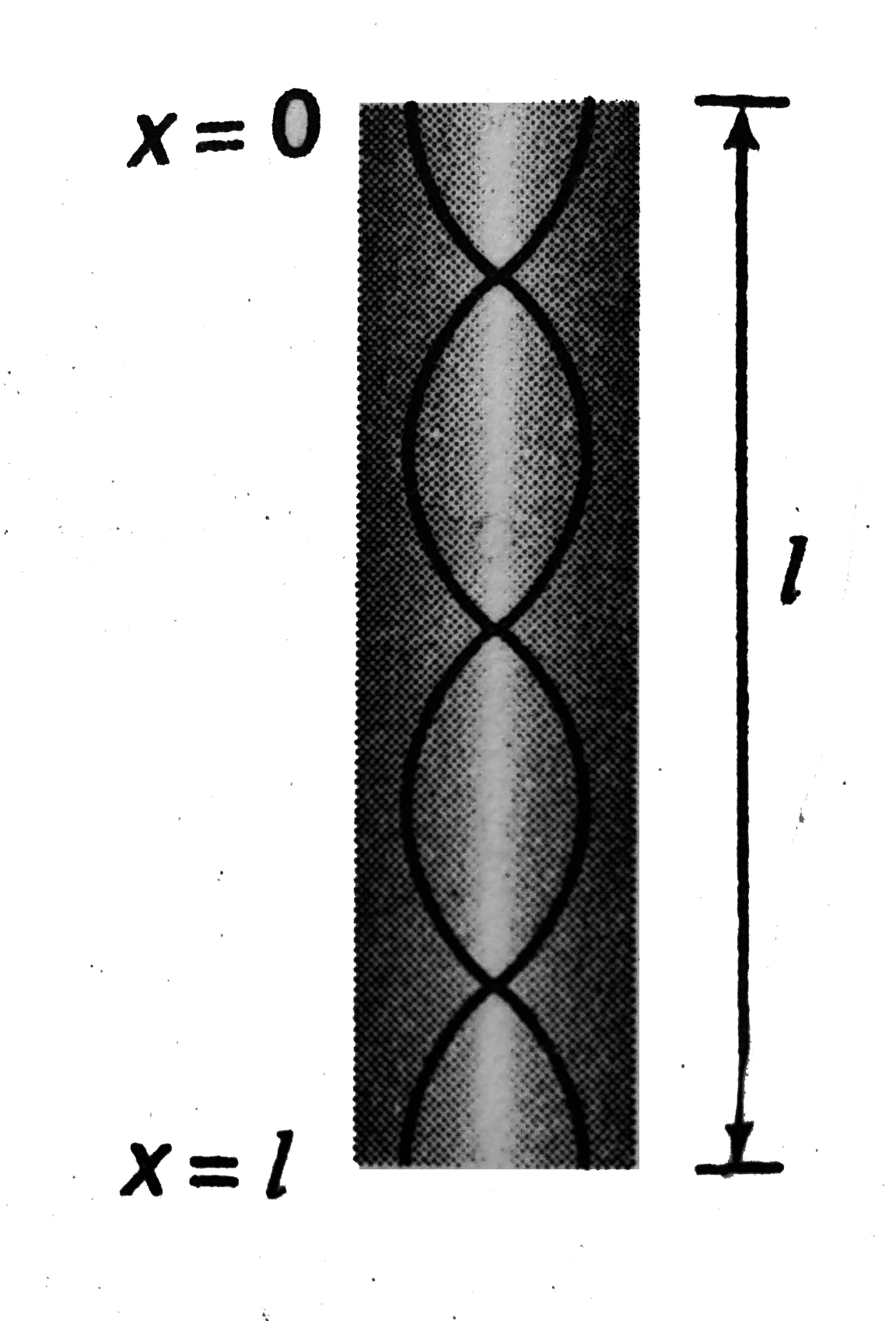A 3m long organ pipe open at both ends is driven to third harmonic standing wave. If the ampulitude of pressure oscillations is 1 per cent of mean atmospheric pressure (po=105Nm2). Find the ampulited of particle displacement and density oscillations. Speed of sound υ=332m/s and density of air ρ=1.03kg/m3.
The correct Answer is:A, B, C
Given length of pipe, l=3m
third harmonic implies that
3(λ2)=l
or λ=2l3=2×33=2m
The angular frequency is
ω=2πf.
=2πνλ=(2π)(332)2 or
ω=332πrad/s
The partical displacement y(x,t) can be written as
y(x,t)=Acoskxsinωt
k=2πλ=2π(2l/3)=3πl
and ω=kν=3πνl (ν=ωk)
∴y(x,t)=Acos(3πxl).sin(3πνl)t
The longitudinal oscillations of an air column can be viwed as oscillations of particle displacement or pressure wave or density wave. Pressure variation is related to particle displacement as
p(x,t)=−B∂y∂x (B= Bulk modulus)
=(3BAπl)sin(3πxl)sin(3πνl)t
The amplitude of pressure variation is
pmax=3BAπl⇒=√Bρ or B=ρν2
∴pmax=3ρν2Aπl or A=pmaxl3ρν2π
Here, pmax=1% or p0=103N/m2
Subsiting the values,
A=(103)(3)(3)(1.03)(332)2π=0.0028m
or A=0.28cm
According to the definition of Bulk modulus (B)
B=−bP(dV/V) ..(i)
Volume =MassDensity or V=mρ
or dV=−mρ2dρ=−Vdρρ
or dVV=−dρρ
Subsituting in Eq. (i), we get
dρ=ρ(dP)B
or ampulitude of density oscillation is
dρmax=ρBpmax=pmaxν2 (ρB=1ν2)
=103(332)2=9×10−3kg/m3

Similar Questions
A 3m long organ pipe both at both ends is driven to third harmonic standing wave . If the amplitude of pressure oscillation is 0.1% of the mean atmospheric pressure (P0=105N/m2). Find the amplitude of
i. particle oscillation and
ii. density oscillation.
Speed of sound v=330m/s,densityofairρ0=1.0kg/m3
View SolutionA sound wave in air has a frequency of 300HZ and a displacement ampulitude of 6.0×10−3mm. For this sound waves calculate the (a) Pressure ampulitude (b) intensity (c ) Sound intensity level (in dB)
Speed of sound =344m/s and density of air =1.2kg/m3.
View Solution
Knowledge Check
An organ pipe of (3.9π)mlong, open at both ends is driver to third harmonic standing wave. If the amplitude of pressure oscillation is 1% of mean atmospheric pressure [po=105N/m2]. The [Given, velocity of sound =200m/s and density of air =1.3kg/m3]
A2.5cmB5cmC1cmD2cmA sound wave having a frequency of 100 Hz and pressure amplitude of 10 pa, then calculate the displacement amplitude (Given speed od sound in air = 340 m/s and density of air = 1.29 kgm3)
A3.63×10−5mB3×10−5mC4.2×10−5mD6.4×10−5mA 10 W source of sound of frequency 1000 Hz sends out wave in air. The displacement amplitude a distance of 10 m from the source is (speed of sound in air = 340 m/s and density of air = 129 kg/m3)
A0.62μmB4.2μmC1.6μmD0.96μm
For a person with normal hearing, the faintest sound that can be at a frequency of 400Hz has pressure amplitude of about 6.0×10−5 Pa . Calculate the corresponding intensity in W/m2 . Take speed of sound in air as 344m/s and density of air 1.2kg/m3 .
View SolutionA 30 cm long pipe is open at both ends. Which harmonic mode of the pipe is resonantly excited by a 1.65 KHz source ? [ Speed of sound in air = 330 m/s]
View SolutionA pipe 30 cm long, is open at both ends. Which harmonic mode of the pipe resonates a 1.1 kHz source? (Speed of sound in air = 330 m s−1)
View SolutionA organ pipe open on both ends in the nth harmonic is in resonance with a source of 1000 Hz The length of pipe is 16.6 cm and speed of sound in air is 332m/s. Find the value of n.
View SolutionThe maximum pressure variation that the human ear can tolerate in loud sound is about 30N/m2 . The corresponding maximum displacement for a sound wave in air having a frequency of 103Hz is
(Take velocity of sound in air as 300 m/s and density of air 1.5kg/m3)
View Solution
